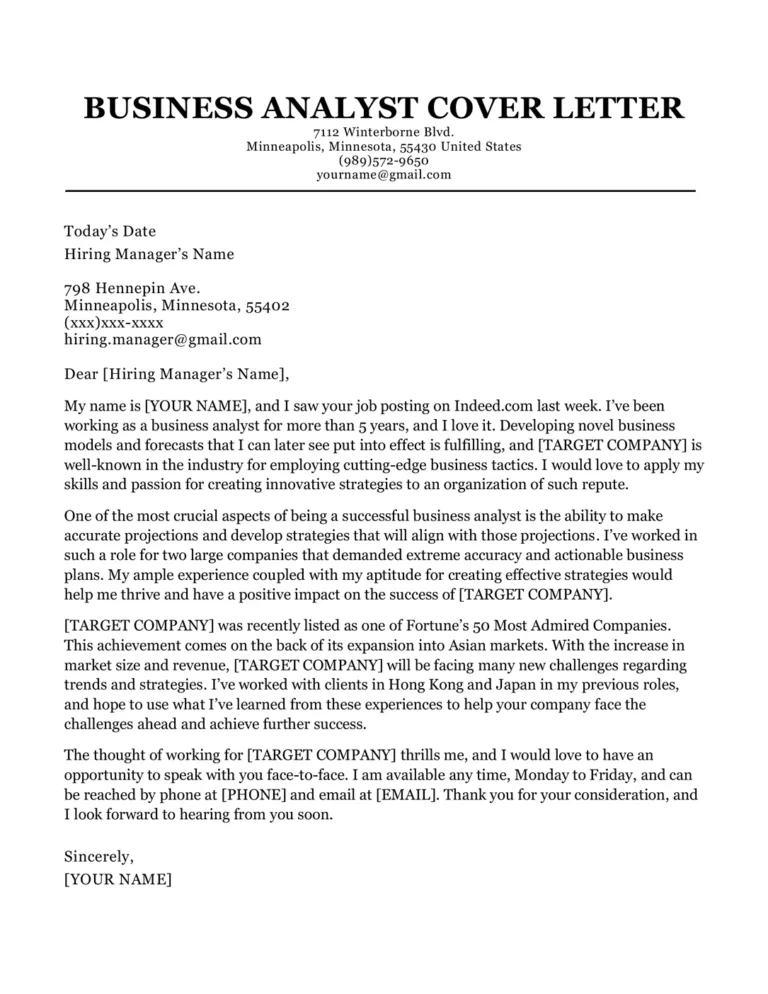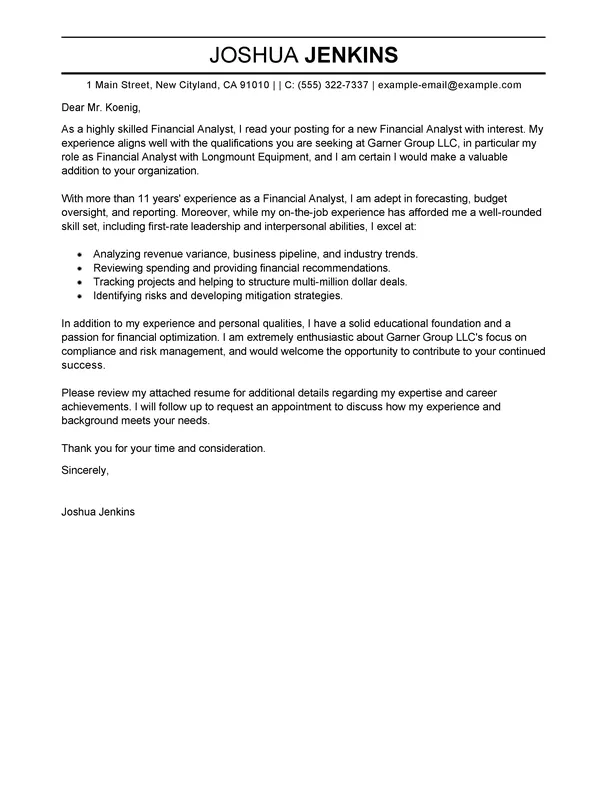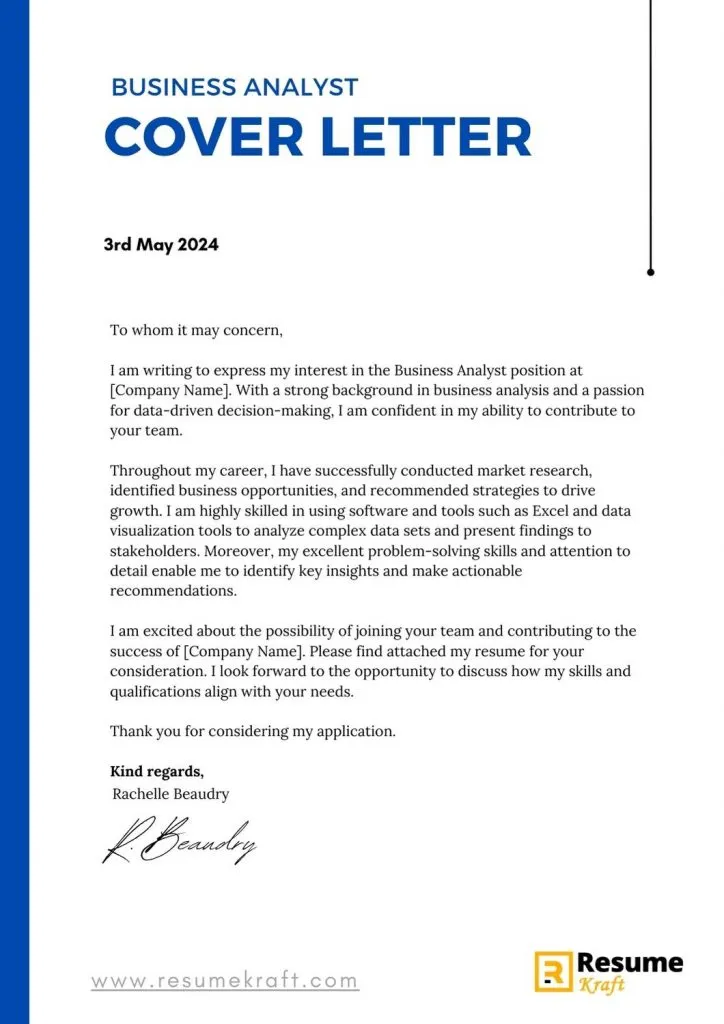Why a Strong Business Analyst Cover Letter Matters
In the competitive landscape of job applications, a well-crafted cover letter for a Business Analyst position is more than just a formality; it’s your first opportunity to make a lasting impression. It serves as a crucial introduction, providing hiring managers with a snapshot of your skills, experience, and personality before they even delve into your resume. Think of it as your personal sales pitch, designed to showcase why you’re the ideal candidate for the role. A compelling cover letter not only highlights your qualifications but also demonstrates your genuine interest in the company and the specific position. It’s your chance to connect with the hiring manager on a more personal level, illustrating how your career goals align with the company’s objectives. A strong cover letter can be the deciding factor in securing an interview, especially when competing against numerous other applicants with similar qualifications. Neglecting this vital component could mean missing out on opportunities, as a poorly written or generic cover letter can signal a lack of attention to detail and a lack of enthusiasm for the role. Ultimately, a well-written cover letter is your key to unlocking the door to a successful job search.
Key Components of an Effective Cover Letter
Crafting an effective cover letter requires a strategic approach that ensures you capture the reader’s attention and demonstrate your value. Begin with a professional header that includes your contact information and the date, followed by the hiring manager’s name (if possible) and title. The opening paragraph is crucial, as it sets the tone for the entire letter. Clearly state the position you’re applying for and where you found the job listing. Immediately capture the reader’s interest by highlighting your most relevant skills or experiences in the first few sentences. The body of the cover letter is where you delve deeper into your qualifications. Focus on showcasing your accomplishments and quantifying your impact whenever possible. Use specific examples to demonstrate how your skills align with the job requirements. Tailor your letter to the specific job description, emphasizing the keywords and requirements mentioned. Don’t simply reiterate your resume; instead, elaborate on your experiences and explain how they make you a great fit for the role. Finally, conclude your cover letter with a strong call to action. Reiterate your interest in the position, thank the hiring manager for their time, and express your enthusiasm for the opportunity to discuss your qualifications further. Be sure to proofread your cover letter meticulously for any grammatical errors or typos.
Highlighting Your Skills and Experience

The most effective cover letters go beyond simply listing skills and experiences; they demonstrate how those skills and experiences translate into tangible results. When highlighting your skills, focus on the ones that are most relevant to the job description. For example, if the job requires strong analytical skills, provide specific examples of how you’ve used those skills to solve complex problems. Quantify your accomplishments whenever possible. Instead of saying you “improved efficiency,” state that you “increased efficiency by 15% through process optimization.” This provides concrete evidence of your abilities and showcases the value you can bring to the role. When discussing your experience, provide context and explain your role in previous projects. Describe the challenges you faced, the actions you took, and the outcomes you achieved. Showcase your knowledge of business analysis methodologies, such as Agile or Waterfall, and how you’ve applied them in real-world scenarios. Remember to tailor your cover letter to each specific job application. While you can use a template as a starting point, it’s essential to customize it to reflect the specific requirements of the position and the company’s culture. This shows that you’ve taken the time to understand the role and are genuinely interested in the opportunity.
Example 1 Cover Letter for Business Analyst with IT Experience
This example emphasizes IT-related experience. The cover letter should highlight experience with software development life cycles (SDLC), system analysis, and experience gathering requirements for IT projects. The candidate should showcase a strong understanding of IT infrastructure, data modeling, and database management. Key accomplishments should include successful implementation of new software systems or improvements to existing ones. Focus on experiences that show ability to collaborate with IT teams, project managers, and stakeholders to define project scope, goals, and deliverables. Highlight your proficiency in IT-specific tools such as SQL, Jira, or other project management software. If you have certifications, such as a PMP or relevant IT certifications, be sure to mention them. This example should show an understanding of how IT projects align with business goals and provide solutions to complex business problems.
Example 2 Cover Letter for Business Analyst with Project Management Experience
This example focuses on project management skills. The cover letter should emphasize project planning, execution, and monitoring. Highlight experience in managing project budgets, timelines, and resources. Mention successful projects that were delivered on time and within budget. Focus on your ability to lead project teams, facilitate meetings, and manage stakeholder expectations. Showcase proficiency in project management methodologies such as Agile, Scrum, or Waterfall. Include experiences that demonstrate your ability to identify and mitigate project risks. Highlight your skills in creating project documentation, such as project plans, status reports, and risk assessments. This example should emphasize your ability to drive projects from initiation to successful completion, ensuring alignment with business objectives.
Example 3 Cover Letter for Business Analyst with Data Analysis Skills

This example is for a candidate with strong data analysis skills. The cover letter should emphasize your proficiency in data mining, statistical analysis, and data visualization. Highlight experience with data analysis tools such as SQL, Python (Pandas, NumPy), R, or Tableau. Mention projects where you analyzed large datasets to identify trends, patterns, and insights. Focus on your ability to translate data into actionable recommendations for business improvement. Showcase your experience in creating data models and dashboards to communicate findings to stakeholders. Include examples of how you’ve used data to improve decision-making, optimize processes, or identify new opportunities. This example should emphasize your ability to provide data-driven solutions and contribute to strategic decision-making.
Example 4 Cover Letter for Business Analyst with Agile Methodology Knowledge
This cover letter example is tailored to candidates familiar with Agile methodologies. It should highlight your understanding of Agile principles and practices, such as Scrum or Kanban. Emphasize your experience in facilitating sprint planning, daily stand-ups, sprint reviews, and retrospectives. Highlight experience in working with cross-functional teams in an Agile environment. Focus on your ability to adapt to changing requirements and deliver value incrementally. Showcase your ability to manage product backlogs, prioritize user stories, and participate in sprint cycles. Mention any certifications related to Agile, such as Certified ScrumMaster (CSM) or Professional Scrum Master (PSM). This example should emphasize your experience in fostering collaboration, promoting continuous improvement, and delivering projects efficiently in an Agile environment.
Example 5 Cover Letter for a Business Analyst with Strong Communication Skills
This example is designed for candidates who want to emphasize their communication skills. The cover letter should highlight your ability to communicate effectively with stakeholders at all levels of an organization. Emphasize your experience in conducting interviews, facilitating workshops, and presenting findings to various audiences. Showcase your ability to write clear and concise documentation, such as requirements specifications, user stories, and process flows. Focus on your experience in bridging the gap between technical and non-technical stakeholders. Mention any experience in conflict resolution or negotiation. Highlight your ability to adapt your communication style to different audiences. This example should demonstrate your ability to build strong relationships, influence others, and effectively convey complex information.
Tips for Customizing Your Cover Letter

Customization is key when creating a cover letter that stands out. Begin by carefully reviewing the job description. Identify the key skills, experiences, and qualifications that the employer is seeking. Then, tailor your cover letter to directly address these requirements. Use the same keywords and phrases that are used in the job description to demonstrate that you possess the necessary skills and experience. Research the company and the hiring manager. Understanding the company’s culture, values, and goals can help you tailor your cover letter to show why you are a good fit. Personalize your cover letter by addressing the hiring manager by name (if possible). This shows that you have taken the time to research the role and the company. Avoid using generic language. Instead, provide specific examples of your accomplishments and the results you achieved. Use action verbs to demonstrate your skills and experiences, and quantify your accomplishments whenever possible. Always proofread your cover letter carefully before submitting it to ensure that there are no grammatical errors or typos.
Proofreading and Polishing Your Cover Letter
Before submitting your cover letter, take the time to proofread and polish it to ensure that it’s free of errors and presents you in the best possible light. Start by reviewing your cover letter for any grammatical errors, spelling mistakes, and typos. Read it aloud to yourself or have someone else read it. This can help you catch errors that you might have missed. Ensure that your cover letter is well-formatted and easy to read. Use a clear font, appropriate font size, and consistent spacing. Make sure your paragraphs are concise and well-structured. Check that your tone is professional and enthusiastic. Your cover letter should reflect your personality and showcase your interest in the role. Tailor your cover letter to the specific job and company. Avoid using a generic template and instead highlight your relevant skills and experiences. Finally, ask a trusted friend, mentor, or career counselor to review your cover letter. Another pair of eyes can catch mistakes and provide valuable feedback.
